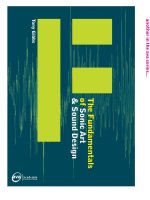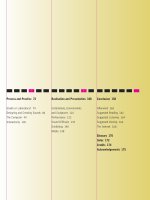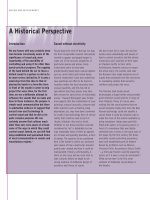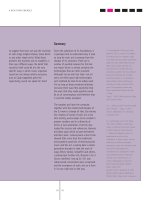Sonic Art & Sound Design- P13 potx
Bạn đang xem bản rút gọn của tài liệu. Xem và tải ngay bản đầy đủ của tài liệu tại đây (678.84 KB, 5 trang )
p60
2
nd
(Job no:76098C1D/O : 09.03.07 Co: CM11)
76098_CTP_040-071.qxd 3/24/07 5:56 AM Page 60
p60
QC Preflight Point
2
nd
1111
Job no : 76098 Title : The Fundamentals Of Sonic Art Client : AVA
Scn :
#
150 Size : 200(w)230(h)mm Co : M11 C0 (All To Spot)(Coagl)
Dept : DTP D/O : 16.02.07
(Job no:76098C1D/O : 09.03.07 Co: CM11)
76098_CTP_040-071.qxd 3/24/07 5:56 AM Page 60
ARTISTS AND THEIR WORK
p60
2
nd
(Job no:76098C1D/O : 09.03.07 Co: CM11)
Have you created a monster?
No I don’t think so, it’s more of a beast!
It’s been in my attic now for a few years:
I use my two-arm ‘Twin’ or ‘Dual’ record
players because they are smaller,
transport easier and don’t get broken. It’s
not a monster or a cross to bear, because
I’ve purposefully tried to do a range of
work beyond that idea. I’m a sound artist:
I use anything to do with sound, but it’s
what people know me for. It’s out there as
an icon of who I am so it’s my emblem,
not a monster. I moved on from it as
quickly as possible really to focus on the
music making which is why I built it. I
was also doing installations and works
like
Recorded Delivery
which was the
first ever piece of sound art that I did, a
great foundation. That’s again just taking
a piece of consumer technology and
putting it through an idea and a process.
Can you say a little about relationships
with technology in your work?
Technology is a tool – not the message. I
don’t just say, ‘Hey, this is made in
MAX/MSP – this is cool’; I go, ‘Well you
take a tape recorder and you do this with
it’, or, ‘you take a record player and you
do that with it’. It’s about the idea and
what you achieve with that idea. The
technology sits there as a real prime focus
for many projects, but it’s not about the
technology; it’s about what I do with it.
Do you have a working definition of sonic
art and how do you distinguish it from
sound design?
I’m an artist that uses sound – it’s as
simple as that. I do concerts and
installations in art galleries where I use
sound as an environment – I’m a visual
artist who focuses on sound. ‘Sound
Design’ relates to particular projects, it’s
a trade thing – in the world where people
do soundtrack composition, they’re called
sound designers and they put the little bits
of sound here and there. For me sonic art
is usually associated with installation, and
composition I think. When I’m being a
sound designer, I’m designing the sound in
the whole space to illustrate the theme of
the exhibition and thinking about it in a
very ‘designed’ way with my architect
friends. I’m designing the sound for the
show and they’re designing the fixtures
and fittings. But when I do an installation
it’s my artwork that I’m producing, not
fulfilling a brief for a client.
Do you feel that sound art is becoming a
more public form?
I think sound art is still a small corner of
the world but it’s global. Audience
76098_CTP_040-071.qxd 3/24/07 5:56 AM Page 60
p60
2
nd
(Job no:76098C1D/O : 09.03.07 Co: CM11)
76098_CTP_040-071.qxd 3/24/07 5:56 AM Page 60
p61
2
nd
(Job no:76098C1D/O : 09.03.07 Co: CM11)
76098_CTP_040-071.qxd 3/24/07 5:56 AM Page 61
p61
2
QC Preflight Point
2
nd
1111
Job no : 76098 Title : The Fundamentals Of Sonic Art Client : AVA
Scn :
#
150 Size : 200(w)230(h)mm Co : M11 C0 (All To Spot)(Coagl)
Dept : DTP D/O : 16.02.07
(Job no:76098C1D/O : 09.03.07 Co: CM11)
76098_CTP_040-071.qxd 3/24/07 5:56 AM Page 61
JANEK SCHAEFER
p61
6160
2
nd
(Job no:76098C1D/O : 09.03.07 Co: CM11)
numbers haven’t necessarily been going up
so I don’t know if it’s achieving more
bums on seats. I’m still very much in a
corner, but I do get the opportunity to
play in big, nice places sometimes. My
album sales haven’t increased but my
commissions have: I don’t have to push
for work so much now which could
indicate it being more widely encouraged.
Look at the number of sound courses that
are popping up: I don’t see that there is a
big market for them to fill. Some of them
will survive and it’s a great education –
you don’t have to become a sound artist. I
trained in architecture, so it’s possible to
use learning skills in other ways.
I’ve been making work with record
players for ten years roughly, and there’s
still only around a dozen well-known
people around the world who are known
for experimental work with record
players. It hasn’t gone up to 120 or
12,000 – it’s still small. People take it a
little more seriously now, especially when
they hear what quality of life I can lead
with all the travelling, and invitations to
make my work etc.
Do you see sound art developing in
particular directions?
It’s very broad, and I like that. There are
so many ways to make it. I see that
museums are slowly making progress
towards accepting it as a valid art form,
and the technology has got to a state of
maturity now which I think is fantastically
enabling for all of us.The only reason that
I can do what I do is because home
computers, flights and the Internet all
became affordable exactly when I started.
Digital technology has developed fast, so
now I can make and release albums and
films at home. You can now also do
almost anything with MAX/MSP (see
pp.98–99), so that opens all the doors you
can ever wish for creatively, if you are so
inclined. I am more keen on the simpler
technologies, which comes back to why
did I make a three-armed record player
instead of using laptop? I enjoy the
physical manipulation of sound: you can’t
get at sound inside a computer with your
hands, but with vinyl, when you play it,
you see the sound being played, and you
can innately understand it. So to
conclude, I’d say that sound art is
spreading everywhere at once, like the
moss in my garden, and I love it – the
varying shades give it character.
76098_CTP_040-071.qxd 3/24/07 5:56 AM Page 61
p61
2
nd
(Job no:76098C1D/O : 09.03.07 Co: CM11)
76098_CTP_040-071.qxd 3/24/07 5:56 AM Page 61
p62
QC
Prefli
g
ht Poin
t
g
2
nd
11
1
1
1
11
1
1
J
ob no : 76098 Title : The Fundamentals
O
f Sonic Art
C
lient : AV
A
S
cn :
#
1
50 Size : 200(w)230(h)mm
C
o : M11
C
0 (All To Spot)(
C
oa
g
l
)
Dept : DTP D/
O
: 16.02.07
(Job no:76098C1D/O : 09.03.07 Co: CM11)
76098_CTP_040-071.qxd 3/24/07 5:57 AM Page 62
p62
2
nd
(Job no:76098C1D/O : 09.03.07 Co: CM11)
76098_CTP_040-071.qxd 3/24/07 5:57 AM Page 62
p62
2
nd
(Job no:76098C1D/O : 09.03.07 Co: CM11)
76098_CTP_040-071.qxd 3/24/07 5:57 AM Page 62
A
RTI
S
T
S
AND THEIR W
O
RK
p62
2
nd
(Job no:76098C1D/O : 09.03.07 Co: CM11)
B
iograph
y
imon Emmerso
n
I
n November 2
00
4 S
U
niversity a
s
j
oined De Montfort
U
T
echnology an
d
P
rofessor in Music
,T
y
University
,
I
nnovation from Cit
y
L
ondon. He
c
ontribute
s
to th
e
d
evelo
p
ment of research in MTI a
s
w
ell as to several under
g
raduat
e
m
odules includin
g
leadin
g
C
ontemporar
y
Composition an
d
A
e
s
theti
cs
.Re
c
ent mu
s
i
c
c
ommi
ss
ion
s
i
nclude works for the Smith Quartet
,
I
nok Paek (kayagum)
,
Philip Sheppar
d
(
electric cello) and Phili
p
Mead (
p
iano
)
w
ith the Ro
y
al Northern College o
f
M
usic Brass Quintet
,
also purel
y
e
lectroacoustic
p
ieces for the IME
B
(
Bour
g
es) and the GRM (Paris). Hi
s
w
orks are available on the Continuum
,
E
manem
,
Mnemosyne (France) an
d
I
sidorart
(
Canada
)
labels. H
e
c
ontributed to
a
nd edited
The
Language of Electroacoustic Music
(
1986
,
Macmillan – still in print)
,
Music, Electronic Media and Culture
(
2000
,
Ashgate) and is a contributor t
o
j
ournals such as
Contemporary Music
Review
a
n
d
Journal of New Music
Research
. He has recently completed a
h
book
,
Living Electroacoustic Music
,for
c
A
sh
g
ate and has two solo CDs du
e
f
rom Sar
g
asso in 2007. He served o
n
t
he Board of
S
onic Arts Network fro
m
i
ts ince
p
tion until 2004
.
S
imon Emmerso
n
Intervie
w
How would you describe your work?
o
u
r
I
think of m
y
work as being
ve electronic
liv
r
a
t
her
t
han
real time
: real time is a term
m
that came in with computers and I like
s
a
working with live musicians. Contrary to
C
what’s been written over the last ten years
l
I don’t believe that humans are being
ar
overtaken by technology: I believe it’s
el
possible that humans can humanise the
m
technologies so I want to reverse the
ve
orthodoxy of the 1990s and bring humans
b
back into the centre of our work. I think
wo
that we can remain live musicians as well
i
c
as electronic musicians. Human beings are
ma
touchy-feely things whereas computers are
co
not. I know that haptic technologies will
no
enable us to interface rather better with
b
computers: the first 25 years of computer
s
music has been through some absurd
e
interfaces not built for human interaction
a
n
at all and the use of games technology is
t
e
beginning to open a huge field of
ld
interactive possibilities, but I still think of
I
s
the human being as a creature that is
r
e
enhanced by the technology, not taken
n
over b
y
it
.
Would you agree that electroacoustic
roa
music comes primarily from academic
m
a
sources and do you feel that this an
a
t
issue?
There are a large number of people who
p
think, ‘Oh that’s elitist’. If they don’t like
e
y
76098_CTP_040-071.qxd 3/24/07 5:57 AM Page 62
p63
2
nd
(Job no:76098C1D/O : 09.03.07 Co: CM11)
76098_CTP_040-071.qxd 3/24/07 5:57 AM Page 63
p63
2
QC Preflight Point
2
nd
1111
Job no : 76098 Title : The Fundamentals Of Sonic Art Client : AVA
Scn :
#
150 Size : 200(w)230(h)mm Co : M11 C0 (All To Spot)(Coagl)
Dept : DTP D/O : 16.02.07
(Job no:76098C1D/O : 09.03.07 Co: CM11)
76098_CTP_040-071.qxd 3/24/07 5:57 AM Page 63
6362
SIMON EMMERSON
p63
2
nd
(Job no:76098C1D/O : 09.03.07 Co: CM11)
the music, that’s fine – it doesn’t worry
me, but there’s a lot of high quality music
being made and I think it should be
valued for what it is. Many of the more
radical artistic developments of the last
20 years end up in colleges and
universities so it’s all one big pool of
possibilities as far as I’m concerned.
Do you think that the public is
becoming more aware of and interested
in sound art?
I’m very happy that the position of sound
in our culture is so strong at the moment.
When I was a student Marshall McLuhan
was telling us that the visual had taken
over. But I think that since that time,
sound and music have moved up steadily
in the public’s appreciation. There’s a lot
more creative interaction between
different kinds of music and I think that’s
fantastically valuable. We’re in a very rich
environment where people come to clubs
to listen to experimental, improvised and
electronic music – it’s not just classic
dance music. There’s a feeling that quite a
lot of popular music themes have run
their course. We all enjoy dancing and
social interaction but we also have a side
that wants to listen to a kind of music
that’s challenging, stimulating, interesting
and different. I think that’s a fantastic
world to live in.
Do you think that visual art has
temporarily exhausted its potential and
that sound is filling the gap?
We’re creatures that love listening to
sound without vision. Every time video
technology has tried to tell us that we
won’t be able to listen to anything
anymore unless it’s got a visual attached
to it, it’s not been true; we love listening
to sound without visual accompaniment.
You can combine the two but you can
listen to sonic art on its own, isolated
from the visual.
Do you think that sonic art exists as a
distinct form? How would you define it?
I think I probably have a different
definition of sonic art than I had 15 or 20
years ago. I personally still focus it
around the interaction of the human with
the technology but artists such as Henri
Chopin, the French concrete poet, need
only a microphone and amplification.
What he does is about the body and the
human voice, it’s not from a music
tradition at all but it’s certainly sonic art.
Of course, sonic art can exist without
electronic technology: a Tinguley
sculpture, for example, is in part sonic art.
I reluctantly include technological
automata although I’m not so interested
in automatic things but how computers
and humans interact. But for me, I’m
76098_CTP_040-071.qxd 3/24/07 5:57 AM Page 63
p63
2
nd
(Job no:76098C1D/O : 09.03.07 Co: CM11)
76098_CTP_040-071.qxd 3/24/07 5:57 AM Page 63
p64
2
nd
(Job no:76098C1D/O : 09.03.07 Co: CM11)
76098_CTP_040-071.qxd 3/24/07 5:58 AM Page 64
p64
QC Preflight Point
2
nd
1111
Job no : 76098 Title : The Fundamentals Of Sonic Art Client : AVA
Scn :
#
150 Size : 200(w)230(h)mm Co : M11 C0 (All To Spot)(Coagl)
Dept : DTP D/O : 16.02.07
(Job no:76098C1D/O : 09.03.07 Co: CM11)
76098_CTP_040-071.qxd 3/24/07 5:58 AM Page 64
ARTISTS AND THEIR WORK
p64
going to include electronic technology, and
a kind of experimental approach to
human/technology interaction.
A lot of electroacoustic work focuses
upon the processes that are used to
create it. What do you feel about this way
of working?
I don’t compose that way. Although I
have an interest in a wide range of genres
and styles within the sonic arts, and I
have a large CD collection, I also teach
composers and I don’t teach all styles
within the field. I have been deeply
involved with the post-Pierre Schaeffer
tradition of acousmatic music. I believe
Denis Smalley when he says that we drive
composition through the ear, that the ear
perceives, that you decide intuitively how
actually to put things together, even
though I personally don’t often compose
that way – though I still try to judge the
results of what I do by ear. I’m really
interested in how composers put sound
together and I think they don’t always tell
the truth about how they do things:
sometimes they claim that they combine
sounds just by listening (and) that they
don’t have any plans or formal schemes in
their minds – but I find this very difficult
to believe in many cases!
In 1993 I wrote a piece for harpsichord
player Jane Chapman. I don’t require the
listener to have the slightest clue as to
how I put it together but it happens to be
structured through the use of Fibonacci
numbers. I used these particular numbers
to create a kind of organic variety of non-
obvious rhythmic combination. Mozart
tended to write 2, 4, 16, 18 and 32 bar
structures but it was when he disobeyed
those ground plans that the music got
interesting. I use numerical sequences to
generate musical structure because I’m
interested in growth patterns and the way
proportions work. I use schemas,
structures and generating procedures,
which I then moderate with my ears to
make sure they work to my satisfaction.
If a composer uses processes, they need
not be obvious to the listener.The most
‘processed’ contemporary music is the
most popular: minimalism. Minimalism fed
into some aspects of the dance revolution
of the 1980s so those kinds of processes
generate quite a popular surface to the
music. If you take an early piece by Philip
Glass or early Steve Reich (see
pp.32–33), you’ve got processes that
generate repetitive patterns or loops,
which are the direct ancestors of loop
programmes that young musicians are
using these days to create loop-based
dance music. But process can also be used
to generate some fantastic music –
Xenakis’ music has recently been the
subject of remixes by Japanese noise
artists. I think this is because the
statistical ideas he used link directly to
ideas of noise and chaos, which act as
metaphors for urban civilisation.
How do you feel about the relationships
between commercial popular music and
experimental music?
I’m interested in all music: I’m interested
in the phenomenon known as music. I love
it. I think that music is one of the most
extraordinary things that humans do and
I’m fascinated by how it feeds into
contemporary culture as we live it now.
The world of sound to me is total: I’m
very interested in environmental sound,
I’m very interested in soundscape and I’m
very interested in the way that humans
articulate through sound. I’m interested
in how sound
signifies
and that is a larger
field than just music. So I think that
music is a subset of sonic art and sonic
art is a subset of soundscape and
soundscape is really the world around us,
virtually complete.
2
nd
(Job no:76098C1D/O : 09.03.07 Co: CM11)
76098_CTP_040-071.qxd 3/24/07 5:58 AM Page 64
p64
2
nd
(Job no:76098C1D/O : 09.03.07 Co: CM11)
76098_CTP_040-071.qxd 3/24/07 5:58 AM Page 64









